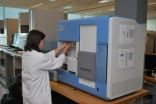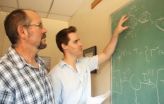(Press-News.org) A break in the two chromosomes has given scientists a break in finding a new gene involved in puberty, Medical College of Georgia researchers report.
It's also helped clear up why some patients with delayed puberty have no sense of smell, said Dr. Lawrence C. Layman, chief of the MCG Section of Reproductive Endocrinology, Infertility and Genetics.
The WRD11 gene interacts with a transcription factor that appears to be involved in development of gonadotropin releasing hormones that enable sexual maturation as well as olfactory neurons in the brain, according to a study published in The American Journal of Human Genetics and funded by the National Institutes of Health. A genetic mutation can diminish or eliminate this important interaction, impairing puberty and the sense of smell.
This was first found in a patient with Kallmann syndrome – delayed puberty coupled with the inability to smell. Next, a variety of WRD11mutations were identified in five other patients with delayed puberty, some of whom also had no sense of smell.
The findings provide insight into normal puberty as well as rare situations in which children don't sexually mature. "Even something that causes a rare disease can have an extremely important function in normal physiology," Layman said. A longer-term goal is finding better therapies for delayed puberty and perhaps alternative birth control methods.
Girls normally develop breasts by age 13 and menstruate by 15. Boys' testicles generally develop by age 14. Sex hormones can be prescribed to prompt puberty when it is delayed but more complex and expensive therapy is required to enable fertility. The therapy can lead to multiple births and related problems such as prematurity.
Layman, who receives blood samples of children and young adults with delayed puberty from across the globe, said the misplacement of portions of two chromosomes in the Kallmann patient worked like a global positioning system to help narrow down the gene search.
The patient had pieces of chromosome 10 on chromosome 12 and vice versa; such recombinations are fairly common and not necessarily bad. But knowing that a recombination can disrupt a gene's function, the researchers analyzed a handful of genes in the immediate vicinity of the break before finding WRD11.
They still have to determine whether the chromosomal swapping had anything to do with the gene dysfunction in this case but the five other patients who had WRD11 mutations did not have the translocation. "Either way, it helped point us in the right direction," said Layman, a corresponding author on the study along with lead author Dr. Hyung-Goo Kim, molecular geneticist in Layman's lab.
"Performing genetic analysis in rare individuals harboring balanced chromosomal locations opens an important portal in the hunt for disease genes," noted Kim, who established the Developmental Gene Discovery Project at MCG to identify genes involved in a wide variety of human genetic disorders.
Layman recently received a $1.5 million grant from the NIH's Eunice Kennedy Shriver National Institute of Child Health and Human Development to learn more about how several of these puberty genes work.
The scientists will be looking further at WRD11, but also CHD7, a gene Kim and Layman identified in 2008, as well as the NELF gene, for fundamentals such as function and frequency. They will also look at more patients and their families to see if they have the same or different genetic variations.
"We have to know, for example, if they are transcription factors, which we think both CHD7 and NELF are. This means that they go into the cell nucleus and turn on expression of other genes," Layman said. "We also have to know what they bind to. It may be that some of these genes work in the same pathway."
Counting WRD11, there are now at least 17 known puberty genes and evidence suggests multiple genetic mutations are involved in some patients. Layman suspects that plenty of those genes are still unknown.
INFORMATION:
Chromosomal break gives scientists a break in finding new puberty gene
2010-10-01
ELSE PRESS RELEASES FROM THIS DATE:
Bedouin tribe reveals secrets to McGill's GA-JOE
2010-10-01
Van Den Ende-Gupta syndrome (VDEGS) is an extremely rare genetic disorder that is characterized by distinctive head and facial features, such as unusual eyelids, narrow and beaked noses, flat nasal bridges, jaw deformities, and a turned out lower lip. As part of McGill's "RaDiCAL" project (Rare Disease Consortium for Autosomal Loci), collaborators in Qatar conducted field research with three patients from biologically interrelated Bedouin families, and sent samples to Canada for analysis by GA JOE – a high-tech genome analyzing machine. The research effort was led by husband ...
Key leukemia defense mechanism discovered by VCU Massey Cancer Center
2010-10-01
Richmond, Va. (September 30, 2010) – Virginia Commonwealth University Massey Cancer Center researcher Steven Grant, M.D., and a team of VCU Massey researchers have uncovered the mechanism by which leukemia cells trigger a protective response when exposed to a class of cancer-killing agents known as histone deacetylase inhibitors (HDACIs). The findings, published in the Journal of Biological Chemistry, could lead to more effective treatments in patients with leukemia and other cancers of the blood.
"Our findings provide new insights into the ways such cancer cells develop ...
'Great strides' in treatment of stroke, headache, epilepsy
2010-10-01
MAYWOOD, Il. -- The latest advances in treating neurologic disorders such as stroke, headache, Parkinson's disease, epilepsy and sleep disorders are detailed in a special issue of the journal Neurologic Clinics.
Guest editor is Dr. Jose Biller, chairman of the Department of Neurology at Loyola University Chicago Stritch School of Medicine.
"Great therapeutic strides in the clinical neurosciences have been made in the past decades," Biller wrote in the preface to the November 2010 issue, now available online. "It is likely that subsequent decades will bring even greater ...
OHSU Toxicology Research Center issues public alert on popular hair salon treatment
2010-10-01
PORTLAND, Ore. — Oregon Health & Science University's Center for Research on Occupational and Environmental Toxicology (CROET) is responding to concerns raised by Portland-area hair salons about a product used for hair straightening. CROET has issued two public alerts describing its findings on the possible negative health impacts of this product.
The product being tested is called Brazilian Blowout. After receiving two samples from Portland-area salons, CROET asked the Department of Consumer and Business Services' Oregon Occupational Safety & Health Division to chemically ...
October 2010 Geology and GSA Today highlights
2010-10-01
Boulder, CO, USA – The October Geology includes a study using fish teeth to understand ocean circulation; discussion of the "Dead Clade Walking" taxa; description of the first reported example of igneous aragonite; discovery of a Paleogene California River, flowing in similar location but opposite direction to the Colorado River; a report of the earliest definite record of predation on pelagic sea lilies; and discovery of the only known active drumlin field in the world. GSA Today examines calderas.
Relationship between mass extinction and iridium across the Cretaceous-Paleogene ...
Turning waste heat into power
2010-10-01
What do a car engine, a power plant, a factory and a solar panel have in common? They all generate heat – a lot of which is wasted.
University of Arizona physicists have discovered a new way of harvesting waste heat and turning it into electrical power.
Using a theoretical model of a so-called molecular thermoelectric device, the technology holds great promise for making cars, power plants, factories and solar panels more efficient, to name a few possible applications. In addition, more efficient thermoelectric materials would make ozone-depleting chlorofluorocarbons, ...
New report on street lighting technologies available from NLPIP at Rensselaer Polytechnic Institute
2010-10-01
Troy, N.Y. – The National Lighting Product Information Program (NLPIP) released its latest Specifier Report, designed to provide objective performance information on existing street lighting technologies -- including light-emitting diode (LED), induction, and high pressure sodium (HPS) streetlights. This report comes at a critical time when many municipalities, some with funding from the American Recovery and Reinvestment Act of 2009, are in the process of replacing HPS streetlights with LED and induction models.
NLPIP, established by Rensselaer Polytechnic Institute's ...
Newly discovered planet may have water on its surface
2010-10-01
A team of astronomers that includes the University of Hawaiʻi' at Manoa's Nader Haghighipour has announced the discovery of a planet that could have liquid water on its surface.
The planet, which is probably 30 percent larger than Earth, was discovered using one of the telescopes of the W. M. Keck Observatory on Mauna Kea. It orbits a relatively small star, Gliese 581, that is 20 light-years from Earth in the constellation Libra.
"By determining the orbit of this planet, we can deduce that its surface temperature is similar to that of Earth," said Haghighipour. ...
NOAA-sponsored scientists first to map offshore San Andreas Fault and associated ecosystems
2010-10-01
For the first time, scientists are using advanced technology and an innovative vessel to study, image, and map the unexplored offshore Northern San Andreas Fault from north of San Francisco to its termination at the junction of three tectonic plates off Mendocino, Calif.
The team includes scientists from NOAA's National Marine Fisheries Service, Oregon State University, the California Seafloor Mapping Program, the U.S. Geological Survey and Woods Hole Oceanographic Institution. The expedition which concludes Sunday is sponsored by NOAA's Office of Ocean Exploration and ...
Underwater robot swims free thanks to York U-designed wireless controller
2010-10-01
TORONTO, Sept. 30, 2010 – A waterproof controller designed and built by York University researchers is allowing an underwater robot to go "wireless" in a unique way.
AQUA, an amphibious, otter-like robot, is small and nimble, with flippers rather than propellers, designed for intricate data collection from shipwrecks and reefs.
The robot, a joint project of York, McGill and Dalhousie universities, can now be controlled wirelessly using a waterproof tablet built at York. While underwater, divers can program the tablet to display tags onscreen, similar to barcodes read ...


